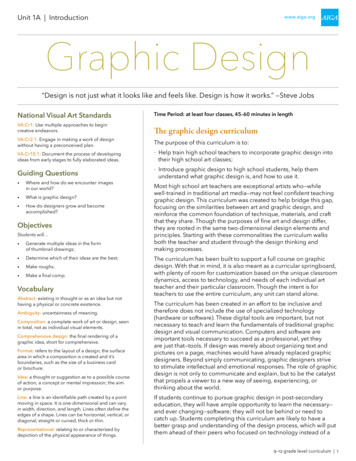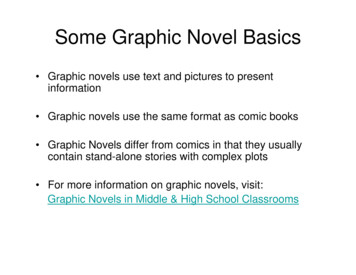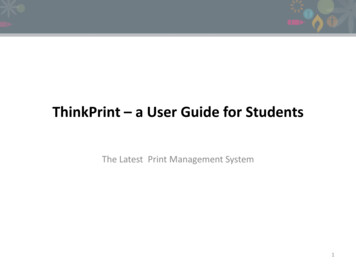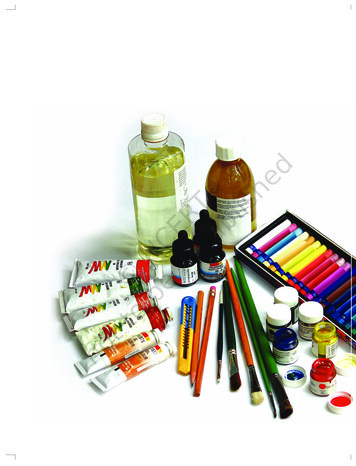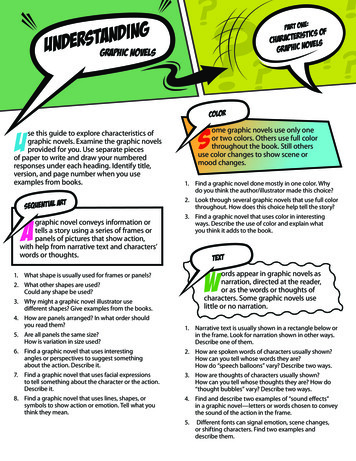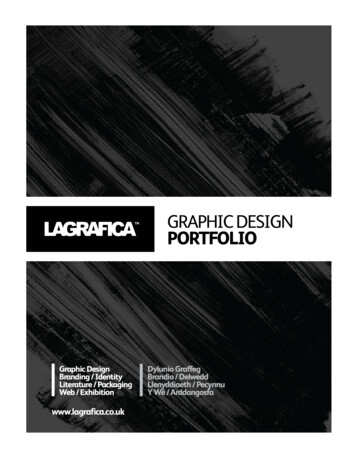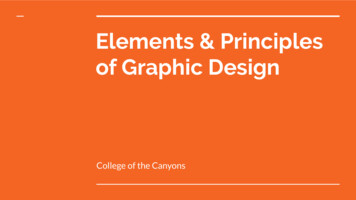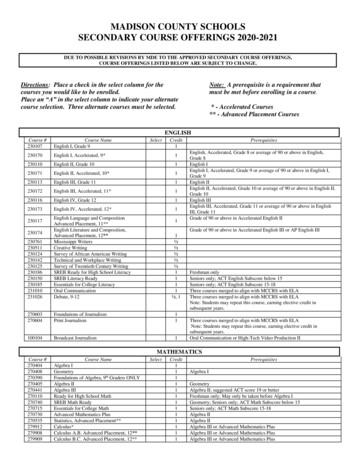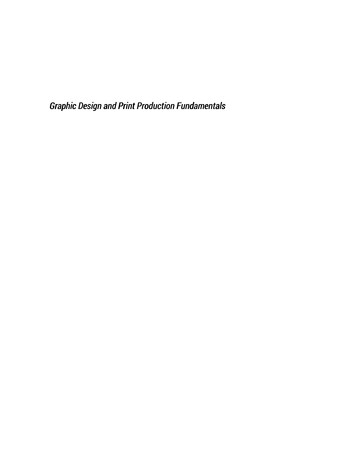
Transcription
Graphic Design and Print Production Fundamentals
Graphic Design and Print ProductionFundamentalsGraphic Communications Open Textbook CollectiveWayne Collins, Alex Hass, Ken Jeffery, Alan Martin, Roberto Medeiros, Steve Tomljanovic
Unless otherwise noted within this book, this book is released under a Creative Commons Attribution 4.0 International License alsoknown as a CC-BY license. This means you are free to copy, redistribute, modify or adapt this book. Under this license, anyone whoredistributes or modifies this textbook, in whole or in part, can do so for free providing they properly attribute the book.Additionally, if you redistribute this textbook, in whole or in part, in either a print or digital format, then you must retain on everyphysical and/or electronic page the following attribution:Download this book for free at http://open.bccampus.caFor questions regarding this license, please contact opentext@bccampus.ca. To learn more about the B.C. Open Textbook project,visit http://open.bccampus.ca .Cover image: Cover is a montage of two images: (https://unsplash.com/photos/WNevBlZWCKA) by Simon Hattinga Verschure and(https://unsplash.com/photos/BVyNlchWqzs) by Amador Loureiro, both licensed under CC0.Graphic Design and Print Production Fundamentals by Ken Jeffery is licensed under a Creative Commons Attribution 4.0International License, except where otherwise noted.
ContentsAbout the BookIntroductionKen Jefferyviii1Chapter 1. Design History1.1 IntroductionAlex Hass61.2 William Morris and the Arts & Crafts MovementAlex Hass91.3 Deutscher WerkbundAlex Hass111.4 BauhausAlex Hass121.5 DadaAlex Hass131.6 International Typographic StyleAlex Hass141.7 Late Modern New York StyleAlex Hass161.8 Post ModernAlex Hass171.9 SummaryAlex Hass19Chapter 2. Design Process2.1 IntroductionAlex Hass222.2 Design Research and Concept GenerationAlex Hass252.3 DefineAlex Hass26iv
2.4 ResearchAlex Hass272.5 Develop ConceptsAlex Hass312.6 Implement SolutionsAlex Hass372.7 SummaryAlex Hass39Chapter 3. Design Elements, Design Principles, and Compositional Organization3.1 IntroductionAlex Hass423.2 Visual Elements -- Basic Things That Can be SeenAlex Hass433.3 Compositional Principles -- Strategies for Arranging Things BetterAlex Hass563.4 Organizational PrinciplesAlex Hass683.5 SummaryAlex Hass75Chapter 4. Colour Management in the Graphic Technologies4.1 IntroductionAlan Martin784.2 Colour ScienceAlan Martin794.3 Measuring DevicesAlan Martin854.4 Lab Colour Space and Delta E MeasurementsAlan Martin874.5 Working with a Spectrophotometer to Read Standard Colour Charts for Output ProfilingAlan Martin904.6 The Measurement File’s Role in Colour ProfilingAlan Martin934.7 Profile CreationAlan Martin964.8 Beyond Output Profiling: Display, Input, and Device Link ProfilesAlan Martin994.9 A Review of the Profile ClassesAlan Martin103v
4.10 The Components and Purpose of a Colour Management SystemAlan Martin1054.11 Applying Colour Management in the Adobe Creative and Kodak Prinergy SoftwareAlan Martin1074.12 SummaryAlan Martin111Chapter 5. Pre-press5.1 IntroductionWayne Collins1145.2 Raster Image ProcessingWayne Collins1165.3 ColourWayne Collins1215.4 TrappingWayne Collins1245.5 TransparencyWayne Collins1285.6 ImpositionWayne Collins1305.7 PreflightWayne Collins1345.8 SummaryWayne Collins135Chapter 6. Imaging6.1 IntroductionRoberto Medeiros1396.2 InkjetRoberto Medeiros1406.3 ElectrophotographyRoberto Medeiros1436.4 Electrophotographic ProcessRoberto Medeiros1466.5 Paper BasicsRoberto Medeiros1526.6 Page Description LanguagesRoberto Medeiros1576.7 Variable Data PrintingRoberto Medeiros161vi
6.8 SummaryRoberto Medeiros166Chapter 7. Web2print7.1 IntroductionSteve Tomljanovic1697.2 E-commerce for Print ManufacturingSteve Tomljanovic1717.3 Web2print Strategies and GoalsSteve Tomljanovic1747.4 Implementation and Workflow ConsiderationsSteve Tomljanovic1797.5 SummarySteve Tomljanovic181GlossaryAbout the Authors183187vii
viii GRAPHIC DESIGN AND PRINT PRODUCTION FUNDAMENTALSAbout the BookGraphic Design and Print Production Fundamentals was created by the Graphic Communications Open TextbookCollective. This creation is a part of the B.C. Open Textbook project.The B.C. Open Textbook project began in 2012 with the goal of making post-secondary education in British Columbiamore accessible by reducing student cost through the use of openly licensed textbooks. The B.C. Open Textbook projectis administered by BCcampus and funded by the British Columbia Ministry of Advanced Education.Open textbooks are open educational resources (OER); they are instructional resources created and shared in waysso that more people have access to them. This is a different model than traditionally copyrighted materials. OER aredefined as teaching, learning, and research resources that reside in the public domain or have been released under anintellectual property license that permits their free use and re-purposing by others (Hewlett Foundation).Our open textbooks are openly licensed using a Creative Commons license, and are offered in various e-book formatsfree of charge, or as printed books that are available at cost.For more information about this project, please contact opentext@bccampus.ca.If you are an instructor who is using this book for a course, please let us know.viii
IntroductionKen JefferyFigure I.1 Car graphics are an example of modern day print designOn any given day, you can look around your surroundings and come in contact with print design. Information comes toyou in many forms: the graphics on the front of a cereal box, or on the packaging in your cupboards; the information onthe billboards and bus shelter posters you pass on your way to work; the graphics on the outside of the cup that holdsyour double latte; and the printed numbers on the dial of the speedometer in your car. Information is communicated bythe numbers on the buttons in an elevator; on the signage hanging in stores; or on the amusing graphics on the front ofyour friend’s T-shirt. So many items in your life hold an image that is created to convey information. And all of thesethings are designed by someone.Figure I.2 Times Square has many examples of print designTraditionally referred to as graphic design, communication design is the process by which messages and images are usedto convey information to a targeted audience. It is within this spectrum that this textbook will address the many stepsof creating and then producing physical, printed, or other imaged products that people interact with on a daily basis.1
2 GRAPHIC DESIGN AND PRINT PRODUCTION FUNDAMENTALSDesign itself is only the first step. It is important when conceiving of a new design that the entire workflow through toproduction is taken into consideration. And while most modern graphic design is created on computers, using designsoftware such as the Adobe suite of products, the ideas and concepts don’t stay on the computer. To create in-storesignage, for instance, the ideas need to be completed in the computer software, then progress to an imaging (traditionallyreferred to as printing) process. This is a very wide-reaching and varied group of disciplines. By inviting a group ofselect experts to author the chapters of this textbook, our goal is to specifically focus on different aspects of the designprocess, from creation to production.Each chapter begins with a list of Learning Objectives, and concludes with Exercises and a list of Suggested Readings onthe Summary page. Throughout, key terms are noted in bold and listed again in a Glossary at the end of the book.In Chapter 1, we start with some history. By examining the history of design, we are able to be inspired by, and learnfrom, those who have worked before us. Graphic design has a very rich and interesting heritage, with inspirations drawnfrom schools and movements such as the Werkbund, Bauhaus, Dada, International Typographic Style (ITS), as well asother influences still seen in the designs of today.Figure I.3 Johannes Itten was a designer associated with the BauhausschoolWe now work in an age where the computer has had an influence on the era of Post Modernism. Is this a new age? Arewe ushering in an era unseen before? Or are modern-day designs simply a retelling of the same tropes we have seen forhundreds of years?Chapter 2 follows with a discussion about the design process. Contrary to what we tend to see in popular televisionshows and movies where advertising executives are struck with instant, usable, and bold ideas, design strategies areseldom insights gained through such a sudden outburst of inspiration. The design process is a deliberate, constructive,and prescriptive process that is guided by specific strategies. For example, before any piece of designed communicationcan be started, some very detailed research needs to be performed. This happens well before any graphic design or layoutsoftware is opened on a computer. Designing is a form of problem solving, where a system is created to communicatea specific and targeted message. The design process is the way that a designer breaks the problem into discrete creativeactivities. First is an exploration of what is trying to be achieved. Facts are gathered about the problem, and the problemitself is often defined very specifically. The idea phase is where brainstorming and ideation occurs, often without
INTRODUCTION 3judgment, as a way to gather as many different ideas and directions as possible. From this, solutions are evaluated, bothfor their perceived impact on the target audience and for their perceived effectiveness in portraying the desired message.Finally, all of this information is distilled into an accepted solution. Designers do not sit around waiting for ideas to justhappen; they follow a process in order to make it happen.Figure I.4 The golden ratio is a constant that appears in natureChapter 3 presents the most important and necessary design elements required for effective graphic layout and design.When designing a layout, the designer cannot just ‘throw’ all of the information onto the page. Design is a thoughtfulprocess that makes use of many different skills to create a design that is both appealing and legible. We discuss the gridin its many forms, including different types of grid such as the ITS grid, the golden ratio, and even strategies for usingno grid at all. Space is an important design element, with different items on the page requiring more or less area to beeffective. We also talk about the density, or ‘colour’ of type on the page, along with a number of different typographicalconventions for making the most of the collection of words on the layout.In Chapter 4, we begin to move along in the production process and discuss some of the more physical attributes ofdesign. And one of the most important topics in creating printed products is that of colour. It is a complex part of thedesign process, affecting how an image is transmitted to the eye, how the colours are perceived, and what makes onething look different from another, even if it is the same colour. Have you ever printed something on your home printeronly to be disappointed that it doesn’t look like it did on your computer screen? Highly detailed systems of colourmanagement are put in place to mitigate these differences.As we proceed toward creating printed output, Chapter 5 is where it all starts to come together. In the print process, thisstage is called prepress. Prepress is where all the design work is translated from a file on the computer in front of youinto a form that can be ‘printed’ onto a given surface. Imagine the requirements for creating not just one copy of a design,but thousands! This is a very important step, and if mistakes or production hurdles are not discovered and overcomeat this step, then the project can end up being very costly for all parties involved, from the designer, to the printer, tothe client. This chapter deals with topics such as preflight, imposition, separations, platemaking, and considerations forother print and finishing processes.Chapter 6 is a comprehensive look at how all of this design work will result in a finished product. The many ways thata design can be printed are varied and complex, but having some knowledge about how the print process works willhelp to create a more successful project. Is it going to be printed on a box, or on a billboard? How many copies areneeded: one or one million? These and many more decisions influence how a product will be produced. This chapteroutlines some of the more popular printing technologies, along with industry standard procedures for working withthem. Suggestions for choosing the right paper (or other types of substrates) are also made along with best practices forworking with colour on the printed page.
4 GRAPHIC DESIGN AND PRINT PRODUCTION FUNDAMENTALSChapter 7 rounds out this textbook with a look at online technologies and how they affect, and are affected by, theprinted word. We examine online web-to-print solutions and their contribution to bridging the process from graphicdesign to printed work. We also highlight other considerations such as branding and digital file resolution strategies. Asthe world has moved into an Internet-connected, always-on compendium of information, print remains a vital, relevant,and important part of the media mix. Effective communication campaigns make the most of all opportunities that mediadesign and, in particular, print design can offer.The goal of this text is to bridge the disciplines of communication design and print production to form a concise,accessible compendium outlining the design process in this modern, computer-driven age. While it is common, orperhaps easy, to surmise that graphic design is solely a computer-driven pursuit, when we take a step back, and look atthe entire process, we see that computer-aided design is only one part of a larger picture. And by including this largerdomain in our studies, we can truly gain an appreciation for the influences and strategies needed to be successful in thisfield.AttributionsFigure I.1Red Bull Mini by User:MB-one is used under a CC BY-SA 2.5 license.Figure I.21 times square night 2013 by Chensiyuan is used under a CC BY-SA 4.0 license.Figure I.3Itten004 by Serge Lachinov is used under a CC BY-SA 3.0 license.Figure I.4Folha by Brunomed is in the public domain.
Chapter 1. Design History
1.1 IntroductionAlex HassLearning Objectives Identify the unique attributes of major modern graphic design styles, beginning with William Morris.The design styles discussed will be those that have a presence or an influence in our current al Typographic Style (ITS)Late ModernPost Modern Evaluate the influence of past design styles on one another Explain the influence of culture on major modern graphic design styles Identify the cross-cultural influences of visual culture that impacted graphic design style Identify the technological influences that affected and advanced graphic designIndustrial Revolution OverviewThe CraftsmanBefore the Industrial Revolution (1760-1840 in Britain) most aspects of design and all aspects of production werecommonly united in the person of the craftsman. The tailor, mason, cobbler, potter, brewer, and any other kind ofcraftsman integrated their personal design aesthetic into each stage of product development. In print, this meant thatthe printer designed the fonts, the page size, and the layout of the book or broadsheet; the printer chose (even at timesmade) the paper and ran the press and bindery. Unity of design was implicit.Typography in this pre-industrial era was predominantly used for books and broadsheets. The visual flavour of the fontswas based on the historic styles of western cultural tradition — roman, black letter, italic, and grotesque fonts were themainstay of the industry. Typography was naturally small scale — needed only for sheets and pages — and was only largewhen it was chiseled into buildings and monuments.Technological ShiftThe Industrial Revolution radically changed the structure of society, socially and economically, by moving vast numbers6
1.1 INTRODUCTION 7of the population from agrarian-based subsistence living to cities where manufacturing anchored and dominatedemployment and wealth. Agrarian-based society was tied to an aristocracy overseeing the land and controlling anddirecting production through the use of human labour. In contrast, urban production, though still very much in needof human labour (female and child labour in particular was in huge demand), was dominated by the mechanizedproduction of goods, directed and controlled by industrialists instead of the aristocracy. The factories were poweredinitially by steam, and eventually by gasoline and electricity. These new manufacturing models were dominated byan engineering mentality that valued optimization of mechanical processes for high yields and introduced acompartmentalized approach to production.Design and Production SeparateThe design process was separated from the production-based process for a number of reasons. Primary was theefficiency-oriented mindset of the manufacturers who were focused on creating products with low unit costs and highyield outcomes, rather than on pleasing aesthetics or high-quality materials. Design process is time consuming and wasconsidered unnecessary for each production stage of manufactured goods.Manufactured products were intended for the working and middle classes, and high-quality output was not a goal.These products were never intended to vie for the attention of the upper classes — enticing them away from the servicesand bespoke products of the craftsman (a contemporary example is Tip Top Tailors attracting Savile Row customers).Rather, they supplied common people with goods they had not been able to afford before. This efficient line of thinkingcreated the still existing equation of minimal design plus low material integrity equalling low-cost products.Design, rather than being a part of each step of production (implicit in the craftsman’s approach), was added for formdevelopment and when a product needed more appeal for the masses — usually during the later stages of productionthrough decorative additions. Design was now directed by the parameters and constraints of the manufacturing processand its needs.Advertising EmergesDespite low product standards, the high quantities and low costs of manufactured goods “stimulated a mass market andeven greater demand” (Meggs & Purvis, 2011, p. 127). The historic role of graphic design for broadsheets and booksexpanded at this point to include advertising. Each company and product needed exposure to sell these manufacturedproducts to the mass market — no earlier method of promotion could communicate to this number of people.The design aesthetic of these times was relatively untouched by stylistic cohesion or design philosophy. Industrialistsused a pastiche of historic styles that aspired to make their products look more upscale, but did not go as far as to createa new visual language. This was a strategy that made sense and has since been repeated (consider early computer designaesthetics). Usually, when a new medium or communication strategy is developed (advertising in print and the posters ofthe Industrial Revolution), it uses visual and language styles that people are already familiar with, and introduces a newway to deliver the message. Too much change alienates, but novelty of delivery works by adding a twist on the shouldersof an already familiar form.Font ExplosionIn addition to its new role in promoting products to the mass market, graphic design moved forward with an explosionof new font designs as well as new production methods. The design of fonts had earlier been linked to the pragmaticand cultural objectives of producing books and broadsheets. With large format posters and numerous other printcomponents, text needed to do much more than represent a phonetic symbol. Innovations in production affected —perhaps infected — printers with the pioneer spirit of the times, and all products and their potential were examined and
8 GRAPHIC DESIGN AND PRINT PRODUCTION FUNDAMENTALSre-evaluated. This attitude naturally included the function and design of fonts and the methods used to reproduce them.Text was often the only material used to promote its subject and became integral to a visual communication. Jobbingprinters who used either letterpress or lithographic presses pushed the boundaries of both, competing with each otherby introducing innovations and, in turn, pushing artists and type foundries to create more products they could use. Anentirely new font category, slab serif — sometimes called Egyptian — was created. Thousands of new fonts emerged tomeet the demand of the marketplace.PhotographyIn addition to font development, the Industrial Age also contributed the photograph and ultimately its use in booksand advertising. Photography (for print design) was originally used as a research tool in developing engravings, butthis was costly and time consuming. Numerous inventors searched for ways to integrate photography into the pressprocess since the early years of its development in the 1830s. Photo engraving eventually arrived in 1871 usingnegatives and plates. From that time forward, photography has been used to conceptually and contextually support thecommunication of graphic design in its many forms.
1.2 William Morris and the Arts & Crafts MovementAlex HassConditions and Products of the Industrial AgeThe Arts & Crafts movement emerged in the second half of the 19th century in reaction to the social, moral, andaesthetic chaos created by the Industrial Revolution. William Morris was its founder and leader. He abhorred the cheapand cheerful products of manufacturing, the terrible working and living conditions of the poor, and the lack of guidingmoral principles of the times. Morris “called for a fitness of purpose, truth to the nature of the materials and methodsof production, and individual expression by both artist and worker” (Meggs & Purvis, 2011, p. 160). These philosophicalpoints are still pivotal to the expression of design style and practice to this day. Design styles from the Arts & Craftsmovement and on have emphasized, in varying degrees, either fitness of purpose and material integrity, or individualexpression and the need for visual subjectivity. Morris based his philosophy on the writings of John Ruskin, a critic ofthe Industrial Age, and a man who felt that society should work toward promoting the happiness and well-being of everyone of its members, by creating a union of art and labour in the service of society. Ruskin admired the medieval Gothicstyle for these qualities, as well as the Italian aesthetic of medieval art because of its direct and uncomplicated depictionof nature.Many artists, architects, and designers were attracted to Ruskin’s philosophy and began to integrate components of theminto their work. Morris, influenced by his upbringing in an agrarian countryside, was profoundly moved by Ruskin’sstance on fusing work and creativity, and became determined to find a way to make it a reality for society. This pathbecame his life’s work.Pre-Raphealite BrotherhoodMorris met Edward Burne-Jones at Exeter College when both were studying there. They both read extensively themedieval history, chronicles, and poetry available to them and wrote every day. Morris published his first volume ofpoetry when he was 24, and continued to write and publish for the rest of his life. After graduation, Morris and BurneJones tried a few occupations, and eventually decided to become artists. Both became followers of Dante Gabriel Rossettiwho founded the Pre-Raphealite brotherhood that was based on many of Ruskin’s principles. Morris did not last long asa painter, eventually finding his design vocation while creating a home for himself and his new wife (Rosetti’s muse andmodel).Discovering the lack of design integrity in Victorian home furnishings and various additional deficiencies in otheraspects of home products, he chose to not only design his home, but all its furniture, tapestries, and stained glass.Morris & Co.In 1860, Morris established an interior design firm with friends based on the knowledge and experiences he had incrafting and building his home. He began transforming not only the look of home interiors but also the design studio. Hebrought together craftsmen of all kinds under the umbrella of his studio and began to implement Ruskin’s philosophyof combining art and craft. In Morris’s case, this was focused on making beautiful objects for the home. The craftsmenwere encouraged to study principles of art and design, not just production, so they could reintegrate design principles9
10 GRAPHIC DESIGN AND PRINT PRODUCTION FUNDAMENTALSinto the production of their products. The objects they created were made and designed with an integrity a craftsmancould feel proud of and find joy in creating, while the eventual owner would consider these products on par withworks of art (an existing example is the Morris chair). The look of the work coming out of the Morris studio wasbased specifically on an English medieval aesthetic that the British public could connect to. The English look andits integrity of production made Morris’s work very successful and sought after. His organizational innovations andprincipled approach gained attention with craftsmen and artisans, and became a model for a number of craft guilds andart societies, which eventually changed the British design landscape.William Morris and the Kelmscott PressMorris’s interest in writing never waned and made him acutely aware of how the book publishing industry had beennegatively affected by industrialization. One of his many pursuits included the revitalization of the book form andits design components through the establishment of the Kelmscott Press. The press was created in 1888 after Morris,inspired by a lecture about medieval manuscripts and incunabula publications, began the design of his first font, Golden,which was based on the Venetian roman face created originally by Nicolas Jenson.In his reinterpretation of this earlier font, Morris strove to optimize readability while retaining aesthetic integrity —in the process reviving interest in font design of earlier periods. Morris used this font in his first book, The Storyof Glittering Plain, which he illustrated, printed, and bound at his press. The design approach of this publication andall others Kelmscott produced in its eight years was based on recreating the integrated approach and beauty of theincunabula books and manuscripts of the medieval period. All aspects of the publication were considered and carefullydetermined to create a cohesive whole. The press itself used hand-operated machinery, the paper was handmade, andthe illustrations, fonts, and page design were all created and unified by the same person to make the book a cohesive,beautiful object of design. Morris did not wholly reject mechanization, however, as he recognized the advantages ofmechanical process. He considered, redesigned, and improved all aspects of design and production to increase physicaland aesthetic quality.Kelmscott Press produced over 18,000 volumes in the eight years of its existence and inspired a revival of book designon two continents. In addition, Morris inspired a reinterpretation of design and design practice with his steadfastcommitment to Ruskin’s principles. Future generations of designers held to Morris’s goals of material integrity —striving for beautiful utilitarian object design and carefully considered functionality.
1.3 Deutscher WerkbundAlex HassIn the early years of the 20th century, the German Hermann Muthesius returned to Germany from England withMorris’s Arts & Crafts concepts. Muthesius published the The English House in 1905, a book wholly devoted to thepositive outcomes of the English Arts & Crafts movement. Muthesius was a sometime cultural ambassador, possiblyan industrial spy, for Germany in England. His interest in the Arts & Crafts movement was not based on returningGerman culture to the romantic values of an earlier pre-manufacturing era. He was focused on infusing the machinemade products of Germany with high-quality design and material integrity. Muthesius believed manufacturing washere to stay. He was one of the original members of the state-sponsored Deutscher Werkbund — an association thatpromoted the union of art and technology. The Werkbund integrated traditional crafts and industrial mass-productiontechniques, and put Germany on a competitive footing with England and the United States. Its motto “Vom Sofakissenzum Städtebau” (from sofa cushions to city-building) reveals its range.Design Embraces the Manufacturing ProcessPeter Behrens and Henry van de Velde were also part of the original leadership, and with Muthesius developedthe philosophy of Gesamtkultur — a cohesive cultural vision where design was the driving force of a wholly fresh,man-made environment. Every aspect of the culture and its products was examined and redefined for maximum useof mechanization in its production. The new visual language of Gesamtkultur was a style stripped of ornament infavour of simplicity and function. All areas of cultural production were affected by this new philosophy — graphicdesign, architecture, industrial design, textiles, and so forth — and all were reconfigured and optimized. Sans seriffonts dominated the reductive graphic design style as did standardization of sizes and forms in architecture andindustrial design. Optimization of materials and mechanical processes affected every area. Germany embraced this newphilosophy and visual style for its simplicity and exactness. In 1919, Walter Gropius, a modernist
Design Elements, Design Principles, and Compositional Organization 3.1 Introduction Alex Hass 42 3.2 Visual Elements -- Basic Things That Can be Seen Alex Hass 43 . Graphic Design and Print Production Fundamentals was created by
